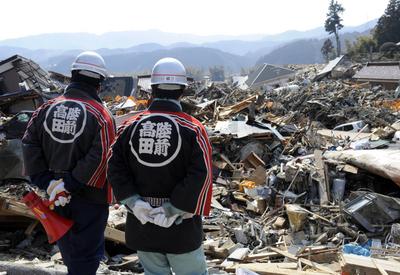In the wake of Japan’s 11 March disaster, a solar energy economic zone should be constructed along the east coast of the Tohoku region.
June 15th, 2011 — Author: Haruo Shimada, Chiba University of Commerce
Local firefighters look at debris in Rikuzentakata city, Iwate prefecture on March 29, 2011. (Photo: AAP)
The damage to the Tohoku region is extensive and profound in so many areas and aspects. To recover from all this devastation, reconstruction of the most severely damaged areas of Tohoku should aim to provide hope for the future, presenting a new direction for Japan to the international community, re-empowering the region and providing employment opportunities to people in the afflicted areas.
Solar energy economic zones, centring on the devastated east coast of the Tohoku region, should be established. This zone would produce five types of energy: (1) solar energy generated by solar panels using sunshine, (2) wind power energy generated by windmills, (3) geothermal energy generated by geothermal power plants, (4) biomass energy generated from unused wood, grass and seaweed, and (5) tidal energy generated by tidal power plants. Essentially, these energies all stem from solar energy. One could also add hydropower as a natural energy source, although this should be derived from technology other than dams, given the detrimental effects to ecological balance brought on by dam construction.
The construction of a solar energy economic zone in the Tohoku region would be meaningful in several senses: it would help Japan establish an optimal energy mix for the near future; it would represent the right direction for a new Japan to extend to the international community by reducing CO2 emissions and the risk of radioactive leaks; it would provide hope and a pride-building objective for afflicted residents; it would provide substantive employment opportunities in the region; and it would contribute to the development of new industries and more robust R&D foundations.
From this, two aspects deserve special consideration: an optimal energy mix and its international implications, and the construction of a solar energy economic zone in the devastated areas.
Optimal energy mix
The current energy mix in Japan consists of 25 per cent nuclear, 40 per cent coal and oil, 25 per cent LNG, and 10 per cent natural renewable energy, of which 8 per cent stems from water power. The average total electrical power supply capacity per hour is about 1 trillion kilowatts. The international community has for decades been pursuing efforts to reduce CO2 emissions through repeated COPs (Conference of Parties) to minimise the ‘greenhouse effect’ on the earth. But, the Fukushima nuclear crisis has given rise to international reconsideration of easy reliance on nuclear energy as a source of electric power generation in the fight against climate change.
The construction of a solar energy economic zone in Tohoku would certainly contribute to this international goal by enabling Japan to reduce its reliance both on oil and coal on the one hand and nuclear energy on the other. A solar energy economic zone in Tohoku will serve as the first step in transforming Japan’s overall energy mix in the near future. Tetsunari Iida of the Environment and Energy Research Institute envisages a reduction of electrical power demand by 20 per cent (down to 80 million kw/h) through technological and structural savings and a new energy mix for 2020 of 10 per cent nuclear energy, 25 per cent coal and oil, 15 per cent LNG, and 30 per cent natural renewable energy, with more than 20 per cent of this being solar energy.
Constructing a Tohoku solar energy economic zone
Solar panels, a few hundred metres in width, would span dozens of kilometres along the devastated coastal area. This array would be extended along a high plateau supported by a number of pillars of 20 metres or so in height to protect it from the danger of tsunamis; living and industrial facilities can be built under the umbrella of these solar panels. Windmills would be built on a large mega-float on the ocean around 10 kilometres off the coast so that they are immune to the hazards of tsunamis and typhoons. Making use of Japan’s shipbuilding technology, several dozen mega-floats would be built, each featuring a few hundred large windmills. These floats can also be utilised as commercial fishing docks and as sites for seaweed nurseries to produce biomass. The further construction of geothermal energy plants and tidal power plants would bring many new industries and R&D centres to this area.
The creation of such facilities would provide ample employment opportunities. If the government spends a trillion yen on the project (US$12.4 billion), more than 100,000 full-time jobs would be created, even when overhead and facility expenses are included. This employment will be multiplied several times through private industrial investment given the ample business opportunities such projects will provide. Many fishermen in this area lost their fishing vessels and food processing facilities because of the tsunami, and many farmers lost their farm land in particular due to salt penetration. Many of them are currently earning their living as day-labourers, cleaning up the waste left by the destruction. It is extremely important to provide these people jobs that offer a meaningful future, allowing them to take pride in helping construct a new Japan.
Haruo Shimada is the President of the Chiba University of Commerce, and has previously served as Chairman of the Economic Research Center, Fujitsu Research Institute, and a special advisor to Japan’s Cabinet Office.


No comments:
Post a Comment